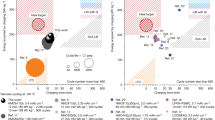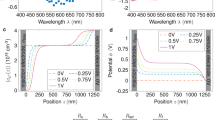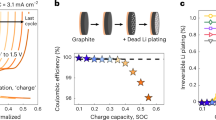Abstract
Lithium metal batteries can achieve high energy density, alleviating range anxiety for electric vehicles. However, the rational interphase design under fast charging conditions remains difficult. Here we explore a series of pyran-based electrolytes with various substitutional anions under a fast charging condition and observe weakly Li+-associating anions facilitating uniform lithium plating under a fast charging condition. We demonstrate lithium metal batteries achieving a 5–70% state of charge (SoC) within 12 min over 350 repeated cycles at a 4C (8.4 mA cm−2) charging rate, as well as high-energy designs delivering projected energy densities of 386 Wh kg−1 reaching a 10–80% SoC within 17 min over 180 cycles. We propose that the improved fast charging performance is in tandem with the ability of the weakly Li+ associating anions to suppress inorganic species clustering within the solid–electrolyte interphase and demonstrate the potential for electrolyte advancement based on the proposed mechanism.
This is a preview of subscription content, access via your institution
Access options
Access Nature and 54 other Nature Portfolio journals
Get Nature+, our best-value online-access subscription
$32.99 / 30 days
cancel any time
Subscribe to this journal
Receive 12 digital issues and online access to articles
$119.00 per year
only $9.92 per issue
Buy this article
- Purchase on SpringerLink
- Instant access to full article PDF
Prices may be subject to local taxes which are calculated during checkout







Similar content being viewed by others
Data availability
The data supporting the findings of this study are included within the Article and its Supplementary Information and source data. Source data are provided with this paper.
References
Liu, J. et al. Pathways for practical high-energy long-cycling lithium metal batteries. Nat. Energy 4, 180–186 (2019).
Tomaszewska, A. et al. Lithium-ion battery fast charging: a review. eTransportation 1, 100011 (2019).
Chen, Y. et al. Origin of dendrite-free lithium deposition in concentrated electrolytes. Nat. Commun. 14, 2655 (2023).
Qian, J. et al. High rate and stable cycling of lithium metal anode. Nat. Commun. 6, 6362 (2015).
Alvarado, J. et al. Bisalt ether electrolytes: a pathway towards lithium metal batteries with Ni-rich cathodes. Energy Environ. Sci. 12, 780–794 (2019).
Nature EnergyRen, X. et al. Enabling high-voltage lithium-metal batteries under practical conditions. Joule 3, 1662–1676 (2019).
Cao, X. et al. Monolithic solid–electrolyte interphases formed in fluorinated orthoformate-based electrolytes minimize Li depletion and pulverization. Nat. Energy 4, 796–805 (2019).
Kim, S. C. et al. High-entropy electrolytes for practical lithium metal batteries. Nat. Energy 8, 814–826 (2023).
Mao, M. et al. Anion-enrichment interface enables high-voltage anode-free lithium metal batteries. Nat. Commun. 14, 1082 (2023).
Zhao, Y. et al. Fluorinated ether electrolyte with controlled solvation structure for high voltage lithium metal batteries. Nat. Commun. 13, 2575 (2022).
Holoubek, J. et al. Tailoring electrolyte solvation for Li metal batteries cycled at ultra-low temperature. Nat. Energy 6, 303–313 (2021).
Yu, Z. et al. Rational solvent molecule tuning for high-performance lithium metal battery electrolytes. Nat. Energy 7, 94–106 (2022).
Yu, Z. et al. Molecular design for electrolyte solvents enabling energy-dense and long-cycling lithium metal batteries. Nat. Energy 5, 526–533 (2020).
Leng, Y. et al. Fast charging of energy-dense lithium metal batteries in localized ether-based highly concentrated electrolytes. J. Electrochem. Soc. 168, 060548 (2021).
Xia, Y. et al. Designing an asymmetric ether-like lithium salt to enable fast-cycling high-energy lithium metal batteries. Nat. Energy 8, 934–945 (2023).
Zheng, J. et al. Electrolyte additive enabled fast charging and stable cycling lithium metal batteries. Nat. Energy 2, 17012 (2017).
Louli, A. J. et al. Diagnosing and correcting anode-free cell failure via electrolyte and morphological analysis. Nat. Energy 5, 693–702 (2020).
Weber, R. et al. Long cycle life and dendrite-free lithium morphology in anode-free lithium pouch cells enabled by a dual-salt liquid electrolyte. Nat. Energy 4, 683–689 (2019).
Liu, Y., Zhu, Y. & Cui, Y. Challenges and opportunities towards fast-charging battery materials. Nat. Energy 4, 540–550 (2019).
Wang, C.-Y. et al. Fast charging of energy-dense lithium-ion batteries. Nature 611, 485–490 (2022).
Tu, S. et al. Fast-charging capability of graphite-based lithium-ion batteries enabled by Li3P-based crystalline solid–electrolyte interphase. Nat. Energy 8, 1365–1374 (2023).
Department of Energy announces $19 million for advanced battery and electrification research to enable extreme fast charging. US Department of Energy https://www.energy.gov/articles/department-energy-announces-19-million-advanced-battery-and-electrification-research-enable (2018).
Wu, Z. et al. Growing single-crystalline seeds on lithiophobic substrates to enable fast-charging lithium-metal batteries. Nat. Energy 8, 340–350 (2023).
Baird, M. A., Song, J., Tao, R., Ko, Y. & Helms, B. A. Locally superconcentrated electrolytes for ultra-fast-charging lithium metal batteries with high-voltage cathodes. ACS Energy Lett. 7, 3826–3834 (2022).
Boyle, D. T. et al. Resolving current-dependent regimes of electroplating mechanisms for fast charging lithium metal anodes. Nano Lett. 22, 8224–8232 (2022).
Niu, C. et al. Balancing interfacial reactions to achieve long cycle life in high-energy lithium metal batteries. Nat. Energy 6, 723–732 (2021).
Lain, M. J., Brandon, J. & Kendrick, E. Design strategies for high power vs. high energy lithium ion cells. Batteries 5, 10660–10669 (2019).
Xia, S. et al. Chemomechanical interplay of layered cathode materials undergoing fast charging in lithium batteries. Nano Energy 53, 753–762 (2018).
Tanim, T. R. et al. A comprehensive understanding of the aging effects of extreme fast charging on high Ni NMC cathode. Adv. Energy Mater. 12, 2103712 (2022).
Adam, A., Wandt, J., Knobbe, E., Bauer, G. & Kwade, A. Fast-charging of automotive lithium-ion cells: in-situ lithium-plating detection and comparison of different cell designs. J. Electrochem. Soc. 167, 130503 (2020).
Jurng, S., Brown, Z. L., Kim, J. & Lucht, B. L. Effect of electrolyte on the nanostructure of the solid electrolyte interphase (SEI) and performance of lithium metal anodes. Energy Environ. Sci. 11, 2600–2608 (2018).
Gu, Y. et al. Resolving nanostructure and chemistry of solid–electrolyte interphase on lithium anodes by depth-sensitive plasmon-enhanced Raman spectroscopy. Nat. Commun. 14, 3536 (2023).
Markevich, E., Salitra, G., Chesneau, F., Schmidt, M. & Aurbach, D. Very stable lithium metal stripping–plating at a high rate and high areal capacity in fluoroethylene carbonate-based organic electrolyte solution. ACS Energy Lett. 2, 1321–1326 (2017).
Aurbach, D., Markevich, E. & Salitra, G. High energy density rechargeable batteries based on Li metal anodes. The role of unique surface chemistry developed in solutions containing fluorinated organic co-solvents. J. Am. Chem. Soc. 143, 21161–21176 (2021).
Cheng, H. et al. High voltage electrolyte design mediated by advanced solvation chemistry toward high energy density and fast charging lithium-ion batteries. Adv. Energy Mater. 14, 2304321 (2024).
Zou, Y. et al. Non-flammable electrolyte enables high-voltage and wide-temperature lithium-ion batteries with fast charging. Angew. Chem. Int. Ed. 62, e202216189 (2023).
Cheng, H. et al. Emerging era of electrolyte solvation structure and interfacial model in batteries. ACS Energy Lett. 7, 490–513 (2022).
Kwon, H. et al. Borate–pyran lean electrolyte-based Li-metal batteries with minimal Li corrosion. Nat. Energy 9, 57–69 (2024).
Wen, B. et al. Ultrafast ion transport at a cathode–electrolyte interface and its strong dependence on salt solvation. Nat. Energy 5, 578–586 (2020).
Aurbach, D. et al. On the surface chemical aspects of very high energy density, rechargeable Li–sulfur batteries. J. Electrochem. Soc. 156, A694 (2009).
Xiong, S., Xie, K., Diao, Y. & Hong, X. Properties of surface film on lithium anode with LiNO3 as lithium salt in electrolyte solution for lithium–sulfur batteries. Electrochim. Acta 83, 78–86 (2012).
Ma, B. & Bai, P. Fast charging limits of ideally stable metal anodes in liquid electrolytes. Adv. Energy Mater. 12, 2102967 (2022).
Li, G. et al. Stable metal battery anodes enabled by polyethylenimine sponge hosts by way of electrokinetic effects. Nat. Energy 3, 1076–1083 (2018).
Kim, S. C. et al. Potentiometric measurement to probe solvation energy and its correlation to lithium battery cyclability. J. Am. Chem. Soc. 143, 10301–10308 (2021).
Seo, D. M., Borodin, O., Han, S.-D., Boyle, P. D. & Henderson, W. A. Electrolyte solvation and ionic association II. Acetonitrile–lithium salt mixtures: highly dissociated salts. J. Electrochem. Soc. 159, A1489 (2012).
Younesi, R., Veith, G. M., Johansson, P., Edström, K. & Vegge, T. Lithium salts for advanced lithium batteries: Li–metal, Li–O2, and Li−S. Energy Environ. Sci. 8, 1905–1922 (2015).
Ushirogata, K., Sodeyama, K., Futera, Z., Tateyama, Y. & Okuno, Y. Near-shore aggregation mechanism of electrolyte decomposition products to explain solid electrolyte interphase formation. J. Electrochem. Soc. 162, A2670 (2015).
Johnson, L. et al. The role of LiO2 solubility in O2 reduction in aprotic solvents and its consequences for Li–O2 batteries. Nat. Chem. 6, 1091–1099 (2014).
Zhu, G. et al. Rechargeable Na/Cl2 and Li/Cl2 batteries. Nature 596, 525–530 (2021).
Hassan, S. A. Microscopic mechanism of nanocrystal formation from solution by cluster aggregation and coalescence. J. Chem. Phys. 134, 114508 (2011).
Wynn, D. A., Roth, M. M. & Pollard, B. D. The solubility of alkali-metal fluorides in non-aqueous solvents with and without crown ethers, as determined by flame emission spectrometry. Talanta 31, 1036–1040 (1984).
Lee, J., Yang, J., Kwon, S. G. & Hyeon, T. Nonclassical nucleation and growth of inorganic nanoparticles. Nat. Rev. Mater. 1, 16034 (2016).
Grammatikopoulos, P., Sowwan, M. & Kioseoglou, J. Computational modeling of nanoparticle coalescence. Adv. Theor. Simul. 2, 1900013 (2019).
Jensen, P. Growth of nanostructures by cluster deposition: experiments and simple models. Rev. Mod. Phys. 71, 1695–1735 (1999).
He, Z. & Alexandridis, P. Nanoparticles in ionic liquids: interactions and organization. Phys. Chem. Chem. Phys. 17, 18238–18261 (2015).
Oncsik, T., Trefalt, G., Borkovec, M. & Szilagyi, I. Specific ion effects on particle aggregation induced by monovalent salts within the Hofmeister series. Langmuir 31, 3799–3807 (2015).
Liu, D. et al. Controlled large-area lithium deposition to reduce swelling of high-energy lithium metal pouch cells in liquid electrolytes. Nat. Energy 9, 559–569 (2024).
Fang, C. et al. Pressure-tailored lithium deposition and dissolution in lithium metal batteries. Nat. Energy 6, 987–994 (2021).
Chen, Y. et al. Trace ethylene carbonate-mediated low-concentration ether-based electrolytes for high-voltage lithium metal batteries. Energy Environ. Sci. 17, 5613–5626 (2024).
Zhang, S. et al. Oscillatory solvation chemistry for a 500 Wh kg−1 Li–metal pouch cell. Nat. Energy 9, 1285–1296 (2024).
Liu, Y. et al. Self-assembled monolayers direct a LiF-rich interphase toward long-life lithium metal batteries. Science 375, 739–745 (2022).
Niu, C. et al. Self-smoothing anode for achieving high-energy lithium metal batteries under realistic conditions. Nat. Nanotechnol. 14, 594–601 (2019).
Niu, C. et al. High-energy lithium metal pouch cells with limited anode swelling and long stable cycles. Nat. Energy 4, 551–559 (2019).
Kim, M. S. et al. Langmuir–Blodgett artificial solid–electrolyte interphases for practical lithium metal batteries. Nat. Energy 3, 889–898 (2018).
Liu, H. et al. Ultrahigh coulombic efficiency electrolyte enables Li||SPAN batteries with superior cycling performance. Mater. Today 42, 17–28 (2021).
Han, J.-G. et al. An electrolyte additive capable of scavenging HF and PF5 enables fast charging of lithium-ion batteries in LiPF6-based electrolytes. J. Power Sources 446, 227366 (2020).
Chen, K.-H. et al. Efficient fast-charging of lithium-ion batteries enabled by laser-patterned three-dimensional graphite anode architectures. J. Power Sources 471, 228475 (2020).
Chen, H. et al. Tortuosity effects in lithium–metal host anodes. Joule 4, 938–952 (2020).
Lee, Y.-G. et al. High-energy long-cycling all-solid-state lithium metal batteries enabled by silver–carbon composite anodes. Nat. Energy 5, 299–308 (2020).
Son, I. H. et al. Graphene balls for lithium rechargeable batteries with fast charging and high volumetric energy densities. Nat. Commun. 8, 1561 (2017).
Yang, X.-G. et al. Asymmetric temperature modulation for extreme fast charging of lithium-ion batteries. Joule 3, 3002–3019 (2019).
Qiao, Y. et al. A high-energy-density and long-life initial-anode-free lithium battery enabled by a Li2O sacrificial agent. Nat. Energy 6, 653–662 (2021).
Du, Z., Wood, D. L. & Belharouak, I. Enabling fast charging of high energy density Li-ion cells with high lithium ion transport electrolytes. Electrochem. Commun. 103, 109–113 (2019).
Wang, B. et al. Ultrafast-charging silicon-based coral-like network anodes for lithium-ion batteries with high energy and power densities. ACS Nano 13, 2307–2315 (2019).
Kazyak, E., Chen, K.-H., Chen, Y., Cho, T. H. & Dasgupta, N. P. Enabling 4C fast charging of lithium-ion batteries by coating graphite with a solid-state electrolyte. Adv. Energy Mater. 12, 2102618 (2022).
Acknowledgements
This work was supported by the LG Energy Solution-KAIST Frontier Research Laboratory (2022) and the National Foundation of Korea (NRF) grant funded by the Korea Ministry of Science and ICT (grant nos. 2022M3J1A1085404 and RS-2023-00261543, H.-T.K.). We thank G.-C. Chung, K. Nam Sohn and J. Young Kim for their support and comments on the research.
Author information
Authors and Affiliations
Contributions
H. Kwon proposed the research, and H.-T.K. supervised the work. H. Kwon conducted the electrochemical tests, SEM and DFT simulations. H. Kwon and Seongyeong Kim performed and analysed the cryo-TEM, XPS and MD simulations. J.H., Y.K. and C.P. helped with the experiment design for the pouch cell test under pressurized conditions. H.E.L., S.S.K. and H. Kim contributed to the pouch cell testing fixture and pressure analysis. C.P., I.J.K., K.S. and Sejin Kim analysed the data. H. Kim and D.S. contributed to the battery design. H. Kwon and H.-T.K. co-wrote and revised the manuscript.
Corresponding author
Ethics declarations
Competing interests
H.-T.K. and H. Kwon declare that this work has been filed for a KR Provisional Patent Application (no. 10-2024-0091552). The other authors declare no competing interests.
Peer review
Peer review information
Nature Energy thanks the anonymous reviewers for their contribution to the peer review of this work.
Additional information
Publisher’s note Springer Nature remains neutral with regard to jurisdictional claims in published maps and institutional affiliations.
Supplementary information
Supplementary Information
Supplementary Figs. 1–67, Tables 1–4 and Notes 1–6.
Source data
Source Data Fig. 5
Statistical source data.
Source Data Fig. 6
Statistical source data.
Source Data Fig. 7
Statistical source data.
Rights and permissions
Springer Nature or its licensor (e.g. a society or other partner) holds exclusive rights to this article under a publishing agreement with the author(s) or other rightsholder(s); author self-archiving of the accepted manuscript version of this article is solely governed by the terms of such publishing agreement and applicable law.
About this article
Cite this article
Kwon, H., Kim, S., Hyun, J. et al. Covariance of interphasic properties and fast chargeability of energy-dense lithium metal batteries. Nat Energy 10, 1132–1145 (2025). https://doi.org/10.1038/s41560-025-01838-1
Received:
Accepted:
Published:
Issue date:
DOI: https://doi.org/10.1038/s41560-025-01838-1
This article is cited by
-
Taming inorganic agglomeration at the interphases
Nature Energy (2025)



